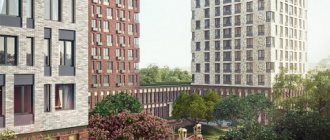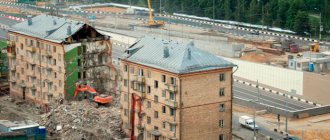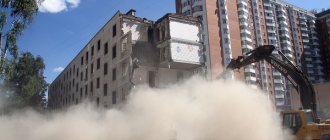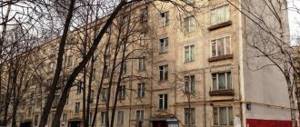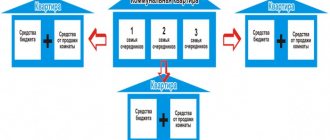Which houses are subject to mandatory demolition?
Houses are put on lists for mandatory demolition according to several principles. Basically, old Khrushchev buildings, built in the 50-60s of the 20th century, fall into this category. Many projects built during this time were built very quickly, which affected the quality. First of all, this concerns the following design types of high-rise buildings, which were erected in a matter of days:
- P-32
- K-7
- 1-464
- P-35
- 1-4681
- MG-300
The houses of these series were built in record time, using low quality materials that wear out quickly. Therefore, the established service life was only 25 years. Thus, these “Khrushchev buildings” have been living quarters for 2 times longer than they were intended for.
Extension of deadlines
The service life of residential buildings subject to demolition may be extended due to the shortsightedness and sluggishness of officials. However, prolonging the resettlement may be fraught with an accident, destruction of the structure and casualties. The process is often delayed due to lack of funding. But the condition of housing is deteriorating, it is becoming dangerous for people. In this case, residents must protect their rights:
- Contact an independent expert who will make a decision to confirm that your home is unfit for habitation. The deadlines will be adjusted, people will receive new housing faster.
- File a lawsuit, attach documentary evidence of the unsuitability of the house, as well as the fact that the situation was ignored by the administration, and request to speed up the resettlement.
- Contact your local prosecutor's office with similar evidence.
The interdepartmental commission considers such applications for approximately 1 month. If assistance is refused, you can use the second method - go to court. The consideration of the case will take about 3 months. If the decision is positive, the terms of dismantling will be changed; if not, then you can go to court again demanding monetary compensation for the purchase of housing.
Delays in resettlement are often explained by the lack of physically accessible real estate in the city and the lack of funds for compensation. It is important to record all possible deterioration of living conditions: collapse of tiles, destruction of masonry, gas and water leaks, cracks in the walls. If the evidence is fully presented to the Department of Housing Policy, then the city authorities will do everything possible to resettle the owners from the dangerous building.
House demolition schedule - addresses of buildings by Moscow districts
Basmanny district
- Bakuninskaya st., vl. 60
- Poslannikov lane, ow. 18-Starokirochny lane, ow. 5
- Krasnoselsky quarter 998, 2/1, building 1,2
- Rusakovskaya st., 6
- Tagansky st. Melnikova, 2
SAO
- Beskudnikovsky district, apt. 8, 9, building 1, 2
- Voykovsky district, Narvskaya st., ow. 5
- Golovinsky district, Avangardnaya st., ow. 10, Flotskaya st., vl. 68, buildings 1 and 2, Onezhskaya st., ow. 35, building 5, 6 and 7, Kronstadt Boulevard, ow. 55, Smolnaya st., ow. 21
- Western Degunino district, Angarskaya st., no. 33, Bazovskaya st., no. 15, st. Taldomskaya, vl.1
- District Koptevo, 3rd Novomikhailovsky Ave., ow. 8, building 1
- Timiryazevsky district, Astradamskaya st., vl. 9 A, Dmitrovskoe highway, ow. 55
NEAD
- Alekseevsky district, st. Staroalekseevskaya, ow. 3
- Butyrsky district, microdistrict. 78, room 66, st. Rustaveli, vl. 3, room 4
- Losinoostrovsky district, st. Izumrudnaya, ow. 26 A, microdistrict 3, room 53, st. Taininskaya, ow. 13
- District Marfino, Gostinichny pr., vl.8, bldg. 2
- District Maryina Roshcha, st. Oktyabrskaya, vl. 1058, Sheremetyevskaya st., vl. 5, k.1, 13, k.1
- Rostokino district, st. Agricultural, building 14
- Sviblovo district, Nansen passage, ow. 8
- District Yuzhnoye Medvedkovo, st. Molodtsova, 33, building 1
- District Yuzhnoye Medvedkovo, Dezhneva proezd, 12, building 1
VAO
- Bogorodskoye Millionnaya st., vl. 3
- Bogorodskoye district, microdistrict. 8 B, room 4
- District Vostochnoye Izmailovo, 13th Parkovaya St., ow. 16, 15th Parkovaya st., ow. 27, 16th Parkovaya st., ow. 12
- Golyanovo Shchelkovskoe highway, 71, building 1 and 73
- Ivanovskoe district, microdistrict. 40-52, rooms 2 and 5
- Izmailovsky Ave., ow. 5
- Kosino-Ukhtomsky district, st. Black Lake, ow. 2-8, Orenburgskaya st., no. 3, Kaskadnaya st., ow. 21, plot 1 and 2
- Metrogorodok district, Otkrytoe highway, ow. 30, 26
- Perovo district, Plekhanova st., ow. 18, 22, 2nd Vladimirskaya st., ow. 30, Zeleny prospect, ow. 27-29
- Northern Izmailovo district, microdistrict. 80, bldg. 7 and 9, Konstantin Fedina st., ow. 13-19
SEAD
- District Vykhino-Zhulebino, microdistrict. 129, Fergana st., no.5
- Kuzminki district, apt. 115, room 1710, building 18; sq. 116, buildings 1 and 2 (Shumilova St., 4); microdistrict 113, st. Young Lenintsev, ow. 42; microdistrict 119, Volgogradsky pr-t, ow. 163; microdistrict 120, st. Zhigulevskaya, vl. 3; microdistrict 120, st. Zelenodolskaya, vl. 28, room 4; microdistrict 118, st. Young Lenintsev, ow. 117, 99; microdistrict 117, st. Young Lenintsev, ow. 73
- Lefortovo district, Shepelyuginskaya st., building 16, apt. 3, room 6
- Lyublino district, microdistrict. A, Lyublinskaya st., 113; microdistrict Zh, Krasnodonskaya st., 46; microdistrict A, Lyublinskaya st., 109, building 1; microdistrict A, Lyublinskaya st., ow. 111, room 211; microdistrict Zh, st. Upper fields, 19, building 2
- Nizhny Novgorod district, apt. 80,
- Ryazan district, microdistrict. 128 A, st. Papernika, 12
- District Tekstilshchiki, st. Chistova, ow. 3 A, page 1
- Yuzhnoportovy district, microdistrict. D, st. Petra Romanova, 18
Southern Administrative District
- Biryulyovo East district, microdistrict. Zagorye, opposite ow. 2
- District Biryulyovo Western, Bulatnikovsky Ave., 16 A; Kharkovsky Ave., near vl. 1
- Danilovsky district, at the intersection of 5th Roshchinsky Ave. and 2nd Roshchinskaya Street; Projected passage 4062, no. 8
- Donskoy district, Sevastopolsky prospect, opposite No. 7,
- Nagatinsky Zaton district, st. Rechnikov, 18-20
- Nagatino-Sadovniki district, Varshavskoe highway, opposite 47, bldg. 2, opposite 61 A
- Nagorny district, Simferopol Ave., ow. 712
- Tsaritsyno district, Yerevan st., opposite 10, building 1; Kavkazsky Boulevard, vl. 40-42; Kantemirovskaya St., opposite No. 27; st. Kantemirovskaya, ow. 37-41; Kaspiyskaya st., 28, building 4; Sevanskaya st., vl. 54-56; st. Bekhtereva, vl. 3, z/u 1 (Tsaritsyno district, microdistrict 4, room 402)
- Chertanovo-Yuzhnoye district, microdistrict 26, room 81-82
South-Western Administrative District
- Academic district, apt. 18, st. Shvernika, ow. 6
- District Zyuzino, apt. 35, B. Yushunskaya st., ow. 7 A; apt. 14, Bolotnikovskaya st., ow. 31; sq. 36, Bolotnikovskaya st., vl. 48; sq. 37, Bolotnikovskaya st., vl. 43; sq. 14, room 3; , sq. 40, Kakhovka st., ow. 2313; sq. 37, Kerchenskaya st., ow. 2; sq. 40, Kerchenskaya st., ow. 20; sq. 42, Kerchenskaya st., ow. 30, 26; sq. 38, Sevastopolsky Ave., ow. 71, ow. 79; sq. 26, 31, Chernomorsky Boulevard, 22/2
- Konkovo district, microdistrict. 6, rooms 2 and 3
- Lomonosovsky district, st. Architect Vlasov, building 2
- Obruchevsky district, intersection of st. Garibaldi and st. Architect Vlasov
- Severnoe Butovo district, Feodosiyskaya st., vl. 7
- Cheryomushki district, apt. 20, 21, Garibaldi st., no. 17
- District New Cheryomushki, apt. 32 A, uch. 12
- Cheryomushki district, apt. 20, 21, Profsoyuznaya st., ow. 32
- District Yuzhnoye Butovo, Krasnolimanskaya st., vl. 27
Company
- Kuntsevo district, Molodogvardeyskaya st., 44
- Kuntsevo district, Bobruiskaya st., 15
- Mozhaisky district, apt. 71, 72, st. Kubinka, 18, building 2
- District Ochakovo-Matveevskoe, apt. 5, B. Ochakovskaya st.; microdistrict 1, Veernaya st.
- Solntsevo district, Shchorsa st., no. 15, st. Aviatorov, st. Rodnikovaya
- Filevsky Park district, Beregovoy proezd, ow. 2, ow. 2, p. 18, vl.2, p.19
- Fili-Davydkovo district, st. Kastanaevskaya, vl. 44-48, bldg. 1 and 2
SZAO
- Mitino district, Novobratsevo district, Parkovaya st., ow. 31 (opposite)
- Northern Tushino district, apt. 5, Turistskaya st., vl. 14, k.1, 2; st. Vilisa Latsisa, ow. 42;
- District Khoroshevo-Mnevniki, apt. 83, Generala Glagolev st., ow. 5, room 1; st. Demyan Bedny, ow. 2215; Karamyshevskaya embankment, building 22, building 2; st. Mnevniki, ow. 10, building 1
- Shchukino district, microdistrict. 12, Novoshukinskaya st., ow. 8
Zelenograd
- Kryukovo Zelenograd, Kryukovo district, microdistrict. No. 19, room 1935, room 1934
- Old Kryukovo Zelenograd, microdistrict No. 9, bldg. 934 – 936
TiNAO
- Mikhailovo-Yartsevskoe village, village. Shishkin forest, near houses 9 and 21
- Ryazanovskoye village, village Banner of October, near 3
The order of demolition of houses 2017-2019
The renovation will be carried out using the wave method. First, a starting facility will be built where the residents of the first liquidated house will be resettled.
In its place, a second building will be erected for residents of the next demolished facility, and so on. According to some experts, the implementation of this program may last 30 years instead of the planned fifteen, that is, it will last until 2047.
Below is an address list of neighborhoods within the boundaries of which it is planned to carry out the design and construction of starting apartment buildings to ensure a wave of resettlement of citizens during 2017-2019.
Central Administrative District
- Presnensky district, Shmitovsky proezd, vl. 39, Mukomolny proezd, ow. 6.
SAO
- Beskudnikovsky district, microdistrict. 5, bldg. 1. Assigned address: Dmitrovskoye sh., 74, bldg. 1.
- Beskudnikovsky district, microdistrict. 5, bldg. 4. Assigned address: Beskudnikovsky Boulevard, 11, building 1.
- Beskudnikovsky district, microdistrict. 5, bldg. 5.
- Beskudnikovsky district, microdistrict. 5, bldg. 6. Assigned address: Beskudnikovsky Boulevard, 13.
- Beskudnikovsky district, microdistrict. 5, bldg. 7.
- Beskudnikovsky district, microdistrict. 5, bldg. 8. Assigned address: Beskudnikovsky Boulevard, 5.
- Beskudnikovsky district, microdistrict. 5, bldg. 9. Assigned address: Beskudnikovsky Boulevard, 3.
- Beskudnikovsky district, microdistrict. 5, bldg. 10. Assigned address: Dmitrovskoe highway, building 68.
- Dmitrovsky district, Dolgoprudnaya st., 12.
- Dmitrovsky district, Dolgoprudnaya st., 7.
- Koptevo, Sobolevsky proezd, 20b.
- Timiryazevsky district, Timiryazevskaya st., vl. 8.
NEAD
- Babushkinsky district, st. Pilot Babushkina, ow. 29, bldg. 2.
- Babushkinsky district, st. Pilot Babushkina, ow. 39.
- Babushkinsky district, st. Pilot Babushkina, ow. 41.
- Babushkinsky district, st. Comintern, ow. 12.
- Northern Medvedkovo, st. Polyarnaya, 22.
- Severnoe Medvedkovo, Shokalsky proezd, vl. 27, bldg. 2.
- Severnoe Medvedkovo, Zarevyi proezd, ow. 9-11.
- Severnoe Medvedkovo, Shokalsky proezd, 33.
- Northern district, Dmitrovskoe highway, vl. 167, bldg. 3A.
- Northern district, Dmitrovskoe highway, vl. 167, bldg. 9A.
- Yuzhnoye Medvedkovo, microdistrict. 1, 2, 3, bldg. 38.
- Yuzhnoye Medvedkovo, microdistrict. 1, 2, 3, bldg. 39.
House relocation schedule for renovation
Below is a list of houses participating in the renovation program that will be relocated between 2021 and 2024. in the administrative district of the Eastern Administrative District
Bogorodskoye
- Boytsovaya st., 18/13
- Ivanteevskaya st., 1/3
- Kuznetsovskaya st., 7
- Millionnaya st., 10
- Millionnaya st., 10 A
- Millionnaya st., 8/2
- Millionnaya st., 8/3
- Otkrytoye shosse, 6/3
- Otkrytoye shosse, 6/4
- Otkrytoe shosse, 6/5
- Otkrytoye shosse, 6/7
- Rokossovsky Marshal Blvd., 10
Eastern Izmailovo
- Izmailovsky Blvd., 7125 building 1
- Izmailovsky Blvd., 7125 bldg. 2
- Izmailovsky Blvd., 7125 room 3
- Parkovaya 16th St., 16/2
- Parkovaya 16th St., 29/1
- Parkovaya 16th St., 29/2
- Sirenevy Blvd., 70/1
Golyanovo
- Amurskaya st., 26
- Amurskaya st., 28
- Amurskaya st., 30
- Amurskaya st., 32
- Amurskaya st., 34
- Amurskaya st., 40
- Amurskaya st., 42
- Amurskaya st., 46
- Amurskaya st., 48
- Amurskaya st., 52
- Amurskaya st., 64
- Amurskaya st., 66
- Amurskaya st., 68
- Amurskaya st., 70
- Amurskaya st., 74
- Baikalskaya st., 14/1
- Baikalskaya st., 16/1
- Baikalskaya st., 16/2
- Baikalskaya st., 16/3
- Baikalskaya st., 16/4
- Shchelkovskoe highway, 31
- Shchelkovskoe highway, 35 building 1
- Shchelkovskoe highway, 35/2
- Shchelkovskoe highway, 37
- Shchelkovskoe highway, 39
- Shchelkovskoe highway, 41
- Shchelkovskoe highway, 43 building 1
- Shchelkovskoe highway, 43/2
- Shchelkovskoe highway, 47 building 1
- Shchelkovskoe highway, 47/2
- Shchelkovskoe highway, 49
- Shchelkovskoe highway, 51
- Shchelkovskoe highway, 53
- Shchelkovskoe highway, 55
- Shchelkovskoe highway, 57/2
- Shchelkovskoe highway, 63
Ivanovskoe
- Zeleny Ave., 101
- Zeleny Ave., 103
- Zeleny prosp., 89 building 1
- Zeleny prosp., 89/2
- Zeleny Ave., 93
- Zeleny Ave., 95
- Zeleny Ave., 97
Izmailovo
- Nikitinskaya st., 15/1
- Nikitinskaya st., 19/1
- Nikitinskaya st., 19/2
- Nikitinskaya st., 19/3
- Nikitinskaya st., 21 building 1
- Nikitinskaya st., 21, building 3
- Nikitinskaya st., 5
- Nikitinskaya st., 8/1
- Nikitinskaya st., 8/2
- Pryadilnaya 1st St., 3
- Pryadilnaya 2nd St., 3/2
- Pryadilnaya 3rd St., 10
- Pryadilnaya 3rd St., 11
- Pryadilnaya 3rd St., 13/1
- Pryadilnaya 3rd St., 13/2
- Pryadilnaya 3rd St., 13/4
- Pryadilnaya 3rd St., 14/1
- Pryadilnaya 3rd St., 14/2
Kosino-Ukhtomsky
- Kamova st., 1
- Kamova st., 22 building 1
- Kamova st., 24/1
- Kamova st., 24/4
- Kamova st., 25, building 5
- Kamova st., 26
- Kamova st., 28
- Kamova st., 3
- Kamova st., 5
- Kamova st., 5A
- Kamova st., 7
- Orenburgskaya st., 1
- Orenburgskaya st., 24/2
- Orenburgskaya st., 4
- Orenburgskaya st., 6/1
- Orenburgskaya st., 6/2
- Orenburgskaya st., 6/3
- Black Lake st., 10
- Chernoe Ozero st., 7/1
- Chernoe Ozero st., 7/2
- Chernoe Ozero st., 7, building 3
- Chernoe Ozero st., no.8
Metrotown
- Nikolay Khimushin st., 15/1
- Nikolay Khimushin st., no. 17, building 2
- Nikolay Khimushin St., 19/1
- Nikolay Khimushin st., 19/2
- Nikolay Khimushin st., 19/3
- Nikolay Khimushin st., no. 21, building 1
- Nikolay Khimushin st., 21/2
- Otkrytoye shosse, no. 25, no. 14
- Otkrytoye shosse, 25, building 15
- Otkrytoe shosse, 26/1
- Otkrytoye shosse, 26/2
- Otkrytoye shosse, 27/5
- Otkrytoye shosse, 27/7
- Otkrytoye shosse, 27/6
- Otkrytoe shosse, 27/4
Perovo
- Vladimirskaya 2nd St., 11D
- Vladimirskaya 2nd St., 15/2
- Vladimirskaya 2nd st., 28 building 1
- Vladimirskaya 2nd St., 30/1
- Green Avenue building 39 building 1
- Green Avenue building 39 building 2
- Green Avenue d.39 k.3
- Green Avenue d.39 k.4
- Metallurgov st., 30
- Metallurgov., 32 k.1
Northern Izmailovo
- Parkovaya 7th St., no. 31 k.2
- Parkovaya 7th St., no. 31 k.3
- Parkovaya 7th St., no. 31 k.4
- Parkovaya 9th St., no. 57
- Parkovaya 9th St., no. 70 k.1
- Parkovaya 9th St., no. 70 k.2
Falcon Hill
- Garazhnaya st., 3
- Garazhnaya st., 3A
- Garazhnaya st., 5
- Sokolinaya Gora 3rd St., 12 A
- Utkina st., 44
- Utkina st., 44A
- Utkina st., 45
The text of the order can be found in more detail here.
“Portrait” of emergency houses
The average age of unsafe houses in the cities studied - Volgograd, Novosibirsk, Nizhny Novgorod, Voronezh, Kazan, Chelyabinsk, Ufa, Rostov-on-Don, Vladivostok, Krasnodar and Yekaterinburg - is 78 years. Typically, the age of unsafe houses, which are located surrounded by dilapidated buildings, is less than that of such houses located in spots. The oldest MKDs are in Rostov-on-Don (age 103 years), and the “youngest” ones are in Kazan (62 years).
Usually in emergency buildings there is a low supply of housing - 14 square meters. m per person. This figure is half the national average - 25 square meters. m per person.
The largest emergency buildings by area are located in Voronezh and Chelyabinsk (more than 500 sq. m.), the smallest in Yekaterinburg and Vladivostok (about 200 sq. m.). Low building density is a factor in the investment attractiveness of redevelopment, including through private investors.
Source: Institute of Urban Economics
List of addresses and relocation schedule by district
Terms are indicated in the range of 4 years. More precise dates may come later or by direct notification to residents prior to the move.
How to find out the deadline for demolition and relocation by address
Lists of addresses by street and moving times are indicated separately for each district of Moscow:
Eastern Administrative District (VAO)
South-Eastern Administrative District (SEAD)Western Administrative District (ZAO)South-Western Administrative District (SWAD)Northern Administrative District (SAO)North-Eastern Administrative District (SVAD)North-Western Administrative District (SZAO)Southern Administrative District (SAO) Troitsky and Novomoskovsky Administrative District (TiNAO) Central Administrative District (CAO) Zelenograd Administrative District (ZelAO)
The relocation plan for renovation may be further adjusted depending on the progress of construction and other conditions.
Order dated 08/12/202 (PDF file)
Order dated February 10, 2021 (PDF file)
Housing that is not subject to demolition
Not all housing built about half a century ago is subject to the demolition program. Some of them meet all standards and meet the requirements of safe living. They were built to different standards, and higher quality and more durable materials were used during construction. They are still suitable for living, and therefore do not fall under the demolition program. These houses include project types.
- 1-515;
- 1-442;
- 1-511;
- 1-510.
These buildings are unbearable. Residents should not wait for imminent dismantling and plan to move to other apartments.
Demolition of housing is an unpleasant episode that causes a lot of inconvenience to residents. To give people time to collect things and adapt, they are given a certain amount of time. Most often, impending demolition is announced by notice, but in some cases additional efforts must be made.
How is the renovation going today?
Program participants most often receive apartments with a larger area than their previous housing. The footage is increased due to the spacious kitchen, separate bathroom and loggia.
For many families, renovation means not only moving to a new house, but also getting a separate apartment instead of a room in a communal apartment.
Most new renovation buildings are comfort class - a courtyard without cars, a stroller room in the entrance, high-speed elevators. The premises have been thoroughly renovated, plumbing and electric stoves have been installed, lighting has been installed, and the loggia has been glazed.
Demolition procedure
The government has not yet announced exact dates for the dismantling of buildings and resettlement of citizens. But it is already known in what order the emergency Khrushchev buildings will be demolished:
- In North-East Administrative Okrug, twenty-eight houses will be dismantled in the fourth quarter of 2021;
- In the Central Administrative District, three buildings will be dismantled by the end of this year;
- In the South-Western Administrative District it is planned to demolish four five-story buildings;
- At the JSC, twenty-seven Khrushchev-era buildings are subject to dismantling;
- Six five-story buildings in North-West Administrative District will be demolished.
Also, by 2021, houses will be dismantled in the Northern Administrative District (Beskudnikovo, Koptevo), Eastern Administrative District (Northern Izmailovo), South-Eastern Administrative District (Kuzminki, Tekstilshchiki), Southern Administrative District (Nagatino), South-Western Administrative District (Kotlovka, Yuzhnoye Butovo).
By the way, in some areas not only five-story buildings will be demolished, but also nine-story ones. Although before this, the capital’s mayor stated that work would only be carried out on buildings consisting of five floors.
Starting sites for construction
Initially, the Moscow government selected about 260 starting sites, which (about 4.5 million sq. m.) can be occupied for the construction of housing for the purpose of relocating residents under the renovation program.
The selection of sites was carried out taking into account the wishes of Muscovites. For many, an important criterion was proximity to the houses included in the program. That is, for many citizens the move will be not only within one district, but even within one block.
This will allow the minimum amount of utility lines to be shifted, but the damage to green spaces will also be minimal.
INTERESTING! Around the new buildings, comfortable neighborhoods will grow that will meet all modern standards. From the houses that have been built or are still under construction, the choice fell on those that meet all the requirements of the Moscow renovation standard.
1st wave
Preliminary calculations show that in 2021 the first wave of demolition of emergency and dilapidated five-story buildings in Moscow, which has been going on for eighteen years, should come to an end.
The goal of this large-scale program is to update the housing stock of the capital city. At the beginning of this year, the second wave of demolition of five-story buildings began.
The first wave of renovation will be implemented this year. There is already a compiled and approved list of houses. In the period until 2019, in accordance with the resettlement program, about 120 thousand residents will be able to move to new housing, which was built according to a new project, and will be included in the new housing stock. Today, new buildings are undergoing finishing to comfort class and by the end of this year 12 houses will be ready for commissioning.
INTERESTING! 3.5 million sq.m. residential space is planned to be built in the first wave. Muscovites from 586 residential buildings will be able to celebrate their housewarming in improved living conditions in new houses that meet modern requirements..
2nd wave
Information about the second wave of renovation came from the capital's mayor at the end of February 2021.
However, despite all the confidence of the city authorities and the mayor in the viability of the program, its fate will depend on the decision of the Constitutional Court. Since the law signed by the President was appealed the very next day.
According to preliminary data, the second wave of demolition should be even larger and more widespread. In accordance with the list of candidates for dismantling, the ongoing reform covered addresses in over 500 districts of the city and about 8,000 structures were included in the final demolition list. In September, it is planned to approve the final schedule of demolished houses of the second wave, after which the practical stage of the reform will be activated.
How to find out if a house is being demolished
First of all, information about demolition comes from the municipality. If the inspection of the house by the interdepartmental commission was initiated by the residents themselves, and the house was declared unsafe, the people living in it must be notified no later than a month before the start of the planned dismantling.
If the demolition will be carried out within the framework of a federal or municipal renovation program, resettlement of citizens from dilapidated and dilapidated housing, that is, initiated by decision of the authorities, notification will be received no later than 1 year before the start of operations. In this case, all residents must sign and thereby confirm that they know about the future demolition of the premises.
Another way to find out about demolition is through online resources. If there is no trust in the state machine that sends out notifications, you can obtain information yourself, through various Internet resources. You can find official information on several portals.
Firstly, this is the website of the city administration and mayor's office. On the portal you need to find the appropriate section and check the lists of houses that are subject to demolition.
Information is also posted on the portal of the Housing Policy Department. Here is a map on which all the houses that are subject to dismantling are marked. Next to each item, the deadlines for completing the work are indicated.
A less reliable, but also accessible resource is the online representations of real estate agencies. Many conscientious real estate agencies provide information to their clients so that they do not purchase an apartment in a building that will be demolished in the near future.
On the Internet you can also find many specialized sites where you can find out the plans of municipal authorities regarding the demolition of dilapidated and uninhabitable housing.
If information is not found on the websites, and doubts remain, you can send a request to the local government authorities yourself. Officials from the Housing Policy Department or the City Administration are required to respond to the request within the established time frame. There are two ways to make a request. The first is a collective letter signed by a group of apartment owners. The second is to place the request in the appropriate section of the local government website (if such a section or request form exists).
The collective letter can be sent by registered mail or registered with the reception office of the mayor's office of the housing department, land management authorities and other suitable organizations. By law, such requests must be considered within 1 month. The same applies to requests sent online through the website.
Renovation in Moscow in 2021
As we have already said, the renovation program will be completed in the first stage at the end of 2021. You can find out when the demolition of a particular building will begin by studying the lists on the official website or by checking the information at the city hall office.
According to official sources, the lists of houses currently announced on websites are not final. The process of coordinating the actions of the government and developers is ongoing, and therefore changes are promptly made to the construction and resettlement priority plan.
The decision on when a particular house will be demolished is made jointly by the authorities and citizens:
- First, a decision of the general meeting of the house is required;
- then - consultation with the elders of the houses;
- the expert opinion of technical specialists is taken into account, determining wear and the degree of risk of further operation of five-story residential buildings subject to renovation.
After all stages have been completed, you should clarify when work begins at the launch site and how the relocation schedule is calculated.
The procedure for replacing residential premises with a new one is designed for the period of construction of a new house, but does not directly depend on this. You can check whether it is possible to move residents into a comfortable, newly constructed building using the official website or by personally contacting the mayor’s office. Construction organizations that directly carry out construction orders also have detailed information.
A specific house is included in the list of buildings to be demolished when the documentation is ready and there is a fully agreed-upon move of the other residents of the house. Information about planned relocation can be found on official websites or read in a personal notice sent by mail.
If the person moving has found a more profitable option and plans to move with an additional payment, it is necessary to submit to the Moscow State Property Department, in addition to the mandatory list of documents, documents on payment for new housing.
What is renovation
Renovation is the replacement of old houses with new ones. Demolition is happening in parallel with construction. People arrive in new homes immediately after moving out. There is no need to wait. This reduces the possibility of manipulation and various dishonest actions on the part of developers.
The implementation period for a large-scale renovation project in Moscow is set until 2032. This is the last time period. By this time, it is planned to re-approve the project and possibly use the experience of reconstruction in other large populated areas of Russia.
The main goal of the project is to change not just one house or neighborhood, but the entire city, turning it into a comfortable living environment.
Houses included in renovation
Why will old houses be demolished in the near future? There are those who say that old buildings can serve for many more years. But it is necessary to take into account not only the wear and tear of concrete, brick, stone, but also obsolescence and the exponentially growing costs of repairing communications.
The longer the service life, the more the costs of repairs and maintaining the house in good condition will begin to increase. At the same time, the comfort of living will remain approximately at the same level. The so-called “enclosing structures” - walls, ceilings, foundations - will remain the same, built in the last century.
That is why the fate of the houses for renovation has been decided in advance - they will have to be demolished in the near future in order to build more durable structures that meet modern comfort requirements. Further exploitation of “Khrushchev” and similar houses will only bring costs disproportionate to the investment.
House demolition schedule
Buildings that are included in Moscow renovation projects will be demolished only after the complete relocation of all residents of the old apartment building. That is, all residents of the old “Khrushchev” must find suitable housing, receive compensation for it, or pay extra for more comfortable housing in another building. Only after all issues related to relocation have been resolved, dismantling of the old house begins.
Renovation and the demolition schedule for old houses depends on many factors: the consent of residents, the availability of a launch site, the readiness of documentation, etc. You can familiarize yourself with the approved list today on the website of the Complex of Urban Development Policy and Capital Construction, as well as by looking at the list of launch sites.
If all organizational issues are settled, the level of wear and tear is also taken into account. If the technical condition of a building indicates possible destruction or irrational operation, it will be a priority on the list of houses for demolition.
Also in the first positions on the list will be houses that are part of a complex development and the demolition of which is required to organize transport interchanges and improve other communications.
The first list already includes houses that are planned for demolition in order to develop the infrastructure of the area, as well as those in which residents gave 100% consent to move.
The Moscow Government is not happy with clear dates for the implementation of the first stage of renovation, but there is a figure - the end of 2021, i.e. We will see the first results already this year. By this time, work on most of the first launch sites will be completed, and the modernization of the public space of the neighborhoods will be implemented at the first stage.
The speed of implementation of renovation projects depends on the placement of old communications at the starting sites. If they need to be moved to provide water, electricity or heat to a large part of the area, the time frame for commissioning new structures will be increased.
Map of demolished five-story buildings and launch sites
How long will the renovation take?
The program will last at least fifteen years. The dismantling and resettlement process will take place in several stages:
- The first stage was completed in 2021. At this stage, lists of emergency and dilapidated premises to be demolished were compiled, and preliminary options for launch sites were selected;
- The second stage was completed in early August 2021. Work with urban planning papers has been completed. This will allow resettlement to be carried out as quickly as possible;
- The third stage will last until December 31, 2021. At this stage, all the nuances of the program should be finalized and detailed, indicating specific deadlines for the dismantling of Khrushchev-era buildings and relocation to new buildings.
In general, the starting stage will last 2 years, during which time 236 houses must be demolished.
How was the list of houses for renovation formed?
The Moscow authorities took into account many aspects important during resettlement:
- availability of free plots of land near demolished houses for the construction of new residential areas;
- compliance of the selected territory with all urban planning, environmental and sanitary safety standards;
- accessibility of public transport;
- possibility of constructing underground/above-ground parking;
- designing apartments of different layouts and sizes, suitable for all categories of citizens, including disabled people and large families;
- possibility to increase the area of the new apartment if necessary.
The renovation schedule also took into account the readiness of old five-story buildings for demolition, for example, whether it is possible to disconnect them from utility networks without reconstruction. If the house passes all the criteria, it will be listed first for resettlement.
It is also said that if residents of dilapidated houses of the first stage move earlier, then resettlers of the second and third waves will be able to choose a new building closer. Since the starting houses will begin to be built on the site of the demolished Khrushchev buildings of the first period.
